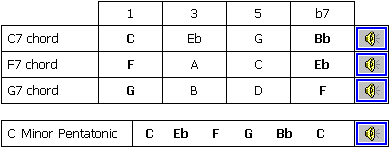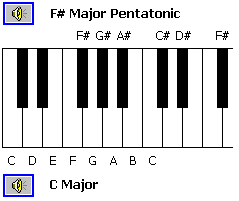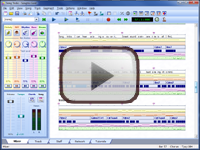(4.7) Pentatonic Scales
Pentatonic scales contain only five notes, as their name suggests (penta = five in Greek). Two of these, commonly used in western music, are the Major Pentatonic and the Minor Pentatonic.


Notice how the A Minor Pentatonic scale contains the same notes as the C Major Pentatonic scale. In other words, they are also modes of each other, in the same way as the A Natural Minor scale is a mode of the C Major scale.

Most ChordWizard products contain the Scale Synonyms tool. This identifies and allows you to explore scale modes, and symmetric scale types which produce identical sets of notes.
The Minor Pentatonic is quite similar to the Blues scale. As with the Blues scale, it contains the root and flat seventh notes of the three chords most often used in blues music.

The difference is that it does not contain the extra ♭5 (tritone) interval which gives the Blues scale the extra tension or 'bite'.
This means that the Minor Pentatonic is a safe choice for improvising over blues, but can end up sounding a little bland if used all the time. In general, the smaller number of notes in these pentatonic scales can be restrictive to the sound of melodies.
Let's compare by playing the Minor Pentatonic scale over the same blues progression as in the previous topic (with the Blues scale).

One other interesting point about these two pentatonic scales is that they can line up neatly with the black keys on the piano. Both the F♯ Major Pentatonic scale and the E♭ Minor Pentatonic scale consist of black notes only.

In other words, if we remove the notes of the Major scale (in this case C Major) from the Chromatic scale, we are left with a Major Pentatonic scale (in this case F♯ Major Pentatonic) starting from the note one tritone away.
It is remarkable how the tritone interval keeps popping up in interesting ways like this. Although it is not part of the Major scale, the tritone is exactly half an octave, and this lends it great importance in music.
|
Topic 53 of 117
| ||
Bring these music concepts to life with the free Songtrix Bronze Edition as you create songs from chords and scales.
Then publish and share your ideas with the other musicians you meet on the ChordWizard Network.
Have questions? Join the ChordWizard Network and post them in the Music Theory forum for answers and discussions on your topics of interest.








